
Menispermum (moonseed) is a small genus of deciduous climbing woody vines in the moonseed family (Menispermaceae). Plants in this genus have small dioecious flowers, and clusters of small grape-like drupes. The name, moonseed, comes from the shape of the seed, which resembles a crescent moon. The word Menispermum is derived from the Greek words μήν (mēn), meaning (crescent) moon, and σπέρμα (sperma) meaning seed. The common name moonseed is also applied to some other species in the related genus Cocculus.

Eriophyllum lanatum, with the common names common woolly sunflower, Oregon sunshine and golden yarrow, is a common, widespread, North American plant in the family Asteraceae.

Wisteria frutescens, commonly known as American wisteria, is a woody, deciduous, perennial climbing vine, one of various wisterias of the family Fabaceae. It is native to the wet forests and stream banks of the southeastern United States, with a range stretching from the states of Virginia to Texas and extending southeast through Florida, also north to Iowa, Michigan, and New York.
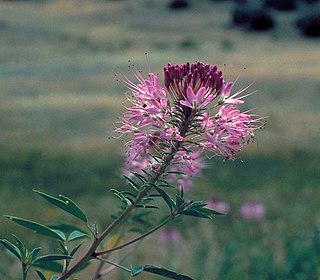
Cleomella serrulata, commonly known as Rocky Mountain beeplant/beeweed, stinking-clover, bee spider-flower, skunk weed, Navajo spinach, and guaco, is a species of annual plant in the genus Cleomella. Many species of insects are attracted to it, especially bees, which helps in the pollination of nearby plants. It is native to southern Canada and the western and central United States. The plant has often been used for food, to make dyes for paint, and as a treatment in traditional medicine.

Bolboschoenus robustus is a species of flowering plant in the sedge family. It is known by many common names: saltmarsh bulrush, alkali bulrush, sturdy bulrush, seacoast bulrush, stout bulrush, three-cornered sedge or leafy three-cornered sedge, and seaside club-rush.

Ceanothus americanus is a species of Ceanothus shrub native to North America. Common names include New Jersey tea, Jersey tea ceanothus, variations of red root, mountain sweet, and wild snowball. New Jersey tea was a name coined during the American Revolution, because its leaves were used as a substitute for imported tea.
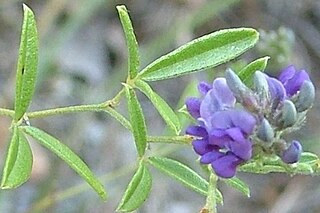
Pediomelum tenuiflorum, the slimflower scurfpea, is a perennial in the pea family. It is about 2–3 feet (0.6–0.9 m) tall and has a lot of leaves on top. Its leaves can reach a length of 3 inches (80 mm). This flower can be found mainly in the central and southwestern U.S.

Yucca aloifolia is the type species for the genus Yucca. Common names include aloe yucca, dagger plant, and Spanish bayonet. It grows in sandy soils, especially on sand dunes along the coast.

Celtis ehrenbergiana, called the desert hackberry or spiny hackberry, is a plant species that has long been called C. pallida by many authors, including in the "Flora of North America" database. It is native to Arizona, Florida, New Mexico and Texas, and to Latin America as far south as central Argentina. It grows in dry locations such as deserts, brushlands, canyons, mesas and grasslands.

Styrax americanus, the American snowbell or mock-orange, is a plant species native to the southeastern United States and the Ohio Valley. It has been reported from Texas and Florida to Virginia and Missouri. It generally grows in swamps and on floodplains and in other wet locations.
Ageratum littorale, the Cape Sable whiteweed, is a plant species native to Florida, the common name referring to Cape Sable inside Everglades National Park. Some publications consider this as being the same species as the West Indian A. maritimum, but The Plant List accepts the two as distinct taxa. It is their lead that we are following here.

Burmannia capitata is a plant species widespread across the West Indies and much of Latin America. It grows in wet areas at elevations less than 100 m. It has been reported from Argentina, Belize, Bolivia, Brazil, Cuba, the Dominican Republic, Haiti, Jamaica, Puerto Rico, Trinidad & Tobago, Colombia, Costa Rica, French Guiana, Guyana, Honduras, southern Mexico, Nicaragua, Panamá, Paraguay, Suriname, Venezuela, and the United States

Parietaria floridana, common name Florida pellitory, is a plant species native to the southeastern United States, the West Indies, and much of Latin America. In the US, the heart of its range extends from Florida, to Georgia and North and South Carolina, with isolated populations reported in Mississippi, Louisiana, Texas, New Hampshire, Kentucky and Delaware. Some populations in California have in the past been referred to as P. floridana but are now regarded as a separate species, P. hespera.

Chaptalia tomentosa, common name pineland daisy, is a plant species native to the southeastern United States. It has been reported from southern Alabama, Florida, southern Georgia, Louisiana, eastern Texas, southern Mississippi, eastern North Carolina and South Carolina. Some publications report the species from the West Indies as well, but this is based on the assumption that C. azurensis is a synonym of C. tomentosa.
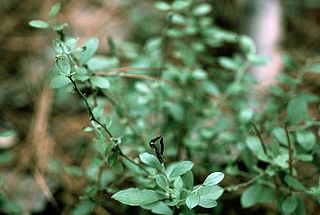
Vaccinium tenellum, the small black blueberry is a plant species native to the southeastern United States from southeastern Mississippi to northern Florida to southern Virginia. It grows in forests and in shrubby areas at elevations up to 200 m.

Sagittaria platyphylla, the delta arrowhead, broad-leaf arrowhead or delta duck-potato, is a plant species native to the eastern United States.
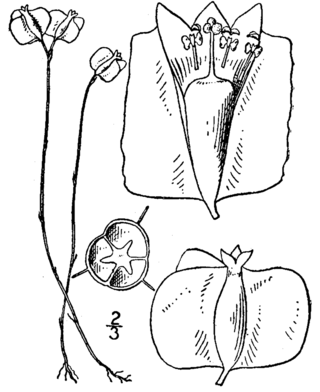
Burmannia biflora, common name northern bluethread, is a plant species native to Cuba, the Bahamas and to the southeastern United States. It has been reported from Puerto Rico, eastern Texas, Louisiana, southwestern Arkansas, southern Mississippi, southern Alabama, Florida, Georgia, South Carolina, North Carolina and southeastern Virginia.

Iris prismatica, the slender blue flag or cubeseed iris, is a plant species native to parts of the southern and eastern United States from Maine south to Alabama, as well as to the Canadian provinces of Ontario and Nova Scotia.

Iris tridentata is a species in the genus Iris, it is also in the subgenus Limniris and in the series Tripetalae. It is a rhizomatous perennial, from the Southeastern United States. It has a cord-like rhizome, bright green leaves, long stem and fragrant flowers in spring in shades of blue.
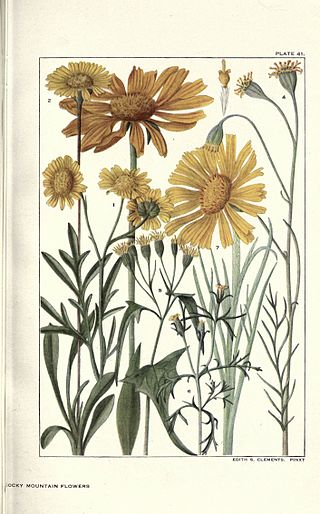
Hymenopappus tenuifolius, the Chalk Hill hymenopappus, is a North American species of flowering plant in the daisy family. It grows in the central and southeastern United States, primarily on the Great Plains from Texas and New Mexico north as far as South Dakota.



















